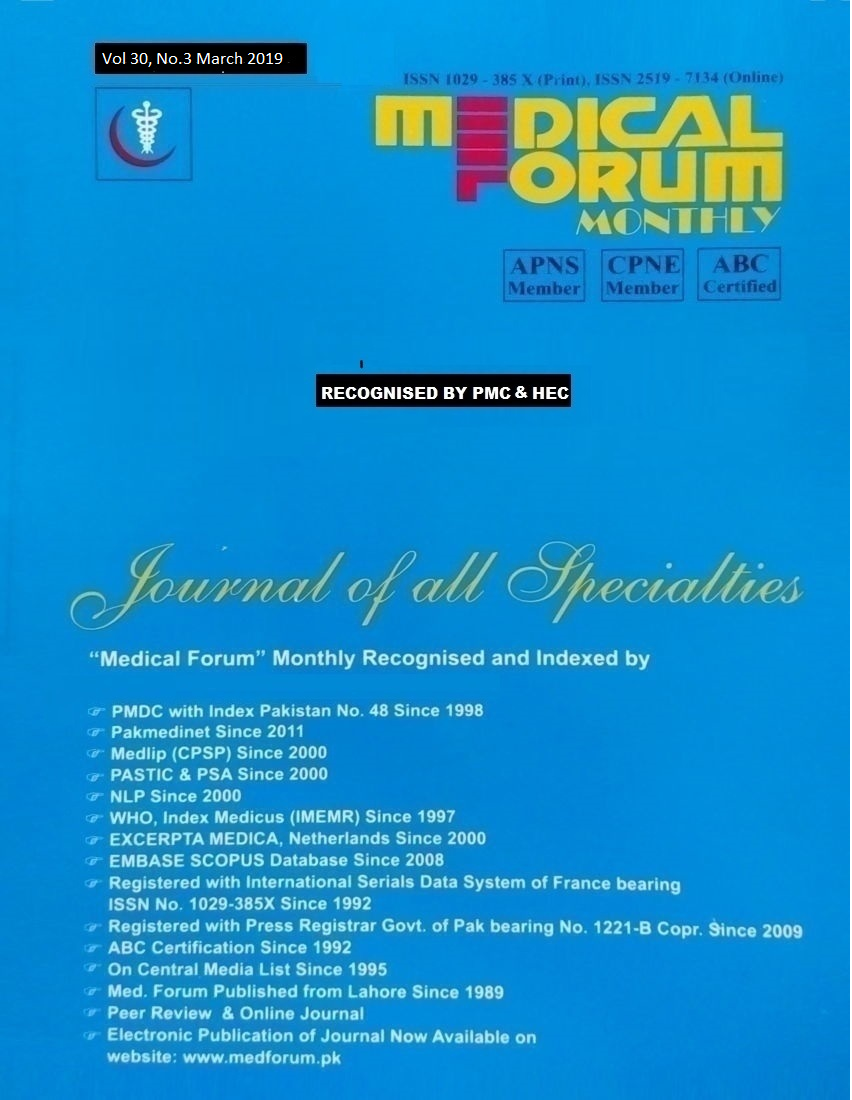
23. Early Refractive and Clinical Outcomes of High Myopic Photorefractive Keratectomy as an Alternative to LASIK Surgery in Eyes with High Preoperative Percentage of Tissue Altered
Abdul Ghafoor1, Mohammad Asad Faraz2 and Muhammad Jahan Zaib Khan2
ABSTRACT
Objective: To assess the effectiveness of high myopic photorefractive keratectomy as an alternative to LASIK surgery in terms of early refractive and clinical outcomes in eyes with high preoperative percentage of tissue altered.
Study Design: Retrospective / observational study
Place and Duration of Study: This study was conducted at the Ophthalmology Department, Bahawal Victoria Hospital Bahawalpur from January 2018 to December 2018.
Materials and Methods: In this study 130 patients were included after getting informed consent from each patient. Medical records of 130 patients were studied in this study.PTA for LASIK surgery, PTA for photorefractive surgery, mean gain in visual acuity, was the outcome variables studied in this research.Postoperative follow up was planned at day 1, week 1 and week 6, month 3 and month 12 after the procedure, at each follow up CDVA, UDVA, slit lamp biomicroscopy and manifest refraction were evaluated at each follow up visit. On the other hand corneal topography was performed at follow up visit at six weeks, three and twelve months.The data was recorded and measured by the researcher himself. Data included age, sex, simulated average PTA , spherical equivalent, average keratometry, pachymetry, preoperative CDVA, actual average PTA with PRK (%), final SE within ±0.50D, final SE within ±1.00D, postoperative CDVA (Snellen decimal), postoperative UDVA (Snellen decimal), safety index, efficacy index, stromal haze.
Results: Actual average PTA was 30.88±2.29% in group-A, 32.25±1.86% in group-B, and 31.08±2.23% in whole cohort (p<0.001). Final SE, which was within ±0.50D of the expected SE, was achieved in 78 (80%) of group-A, 50 (75%) in group-B and 103 (79%) on the whole cohort (p=0.707). Final SE, which was within ±1.00D of the expected SE, was achieved in 90 (92%) of group-A, 58 (87%) in group-B and 118 (91%) on the whole cohort (p=0.511). Mean postoperative CDVA was 0.88 in group-A, 0.89 in group-B, and 0.88 in the whole cohort (p=0.001). Mean postoperative UDVA was 0.83 in group-A, 0.82 in group-B, and 0.83 in the whole cohort (p=0.689). Mean safety index was 1.047 in group-A, 1.046 in group-B, and 1.047 in the whole cohort (p=0.121). Mean efficacy index was 1.017, 1.018 and 1.017 in group-A, group-B and whole cohort, respectively (p=0.352). Stromal haze was observed in 10 (10%) of group-A eyes, 6 (9%) of group-B eyes and 11 (8.5%) of the total 130 eyes (p=0.901). Table-2
Conclusion: It can be concluded that photorefractive keratectomy is effective and safe in the treatment high myopia eyes thus it can be applied as safe alternative to LASIK in cases where there is risk of development of high ectasia due to high PTA score.
Key Words: Myopic Photorefractive, Keratectomy, LASIK, Ectasia
Citation of article: Ghafoor A, Faraz MA, Khan MJZ. Early Refractive and Clinical Outcomes of High Myopic Photorefractive Keratectomy as an Alternative to LASIK Surgery in Eyes with High Preoperative Percentage of Tissue Altered. Med Forum 2019;30(3):91-94.
